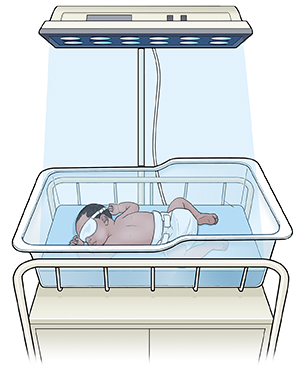Phototherapy for Newborn Jaundice
Jaundice is when the skin and the whites of the eyes look yellow. It happens from a buildup of bilirubin. This is a yellow substance in the body. It’s made when red blood cells break down. Bilirubin is processed by the liver. It then leaves the body through urine and stool. If a baby isn’t eating and pooping very much, it's harder for them to get rid of bilirubin.
When jaundice needs treatment
Jaundice is common after birth. A baby's red blood cells break down more easily and their liver is less mature. About half of all newborn babies have jaundice in their first week of life. It’s usually temporary and doesn’t need treatment.
But some babies have severe jaundice. This is a sign that their body can’t break down the bilirubin fast enough. If too much builds up, it can harm a baby's brain and nervous system. In these cases, the baby needs phototherapy. This means exposing the skin to light. It helps speed up the breakdown of bilirubin. It changes it into a form that can leave the body more easily.
How it works
Phototherapy lamp
One way to treat jaundice is with a phototherapy lamp. This is often done in a hospital. Your baby will be placed under a special light. This light changes the form of the bilirubin in the skin. Phototherapy is often prescribed in single, double, or triple units. This means how many light sources are used. Your baby's healthcare provider will determine how many units to use.
During treatment, your baby’s eyes are covered for protection and comfort. The rest of their body is naked, except for a diaper. This way the light reaches most of their skin. The staff will change the baby’s position often. This is to make sure all of your baby's skin is exposed to the light.
If the bilirubin levels are not severe, treatment may be paused for feeding and skin-to-skin care. The healthcare team will closely watch your baby's bilirubin levels, temperature, and fluids (hydration) during phototherapy. You will need to feed your baby often. Feeding 8 to 12 times a day will help get rid of the bilirubin.

Bili blanket
Another way to treat jaundice is with a lighted pad called a bili blanket. This pad uses light from tiny fiberoptic cables or LED lights. The pad may be used in the hospital or at home. For phototherapy at home, the healthcare team will give you instructions for how to use the bili blanket. Your healthcare provider will order a home health referral.
The bili blanket has a cover. Wrap your baby in the blanket. Make sure the lighted section of the pad is in contact with the baby's skin. Don't block the air vents of the fiberoptic box.
Feed your baby often. This will help lower bilirubin levels. Feed your baby 8 to 12 times daily. If you’re breastfeeding, keep doing it. You can remove the bili blanket when you feed your baby. Put it back on your baby's skin as soon as you're done.
It's important to keep your baby's skin clean. Don't use lotions or oils on your baby's skin. Change their diaper often. Check the skin under the bili blanket about every 2 hours and at diaper changes. Look for any red spots or sores on the skin.
Your baby will need a follow-up blood test to check bilirubin levels.
When to call the healthcare provider
Call the healthcare provider if your baby:
- Has skin that turns red
- Has a bad diaper rash
- Has skin that stays yellow
- Refuses feedings
- Won't wake up
- Has any change in activity
- Arches their back or neck
- Starts to have a high-pitched cry
How long will phototherapy be needed?
Phototherapy may be needed for a few days to a week. The healthcare provider will tell you how long your baby needs therapy and if it can be done at home. Your baby's bilirubin level will be watched closely during treatment. This will help the healthcare provider determine when therapy can be stopped.
You'll need to limit the amount of time your baby spends away from the light. This is to give the best results possible.
If the bilirubin levels are not too high, you may be able to hold your baby for feedings and skin-to-skin care. The baby may get fluids through an IV (intravenous) line at the hospital if the bilirubin levels are too high or rising. This causes the baby to urinate more often. This helps the bilirubin leave the body faster.